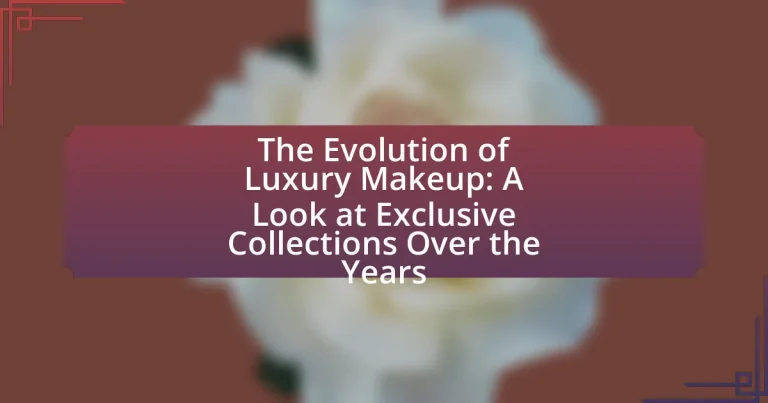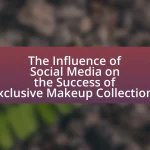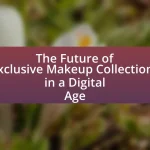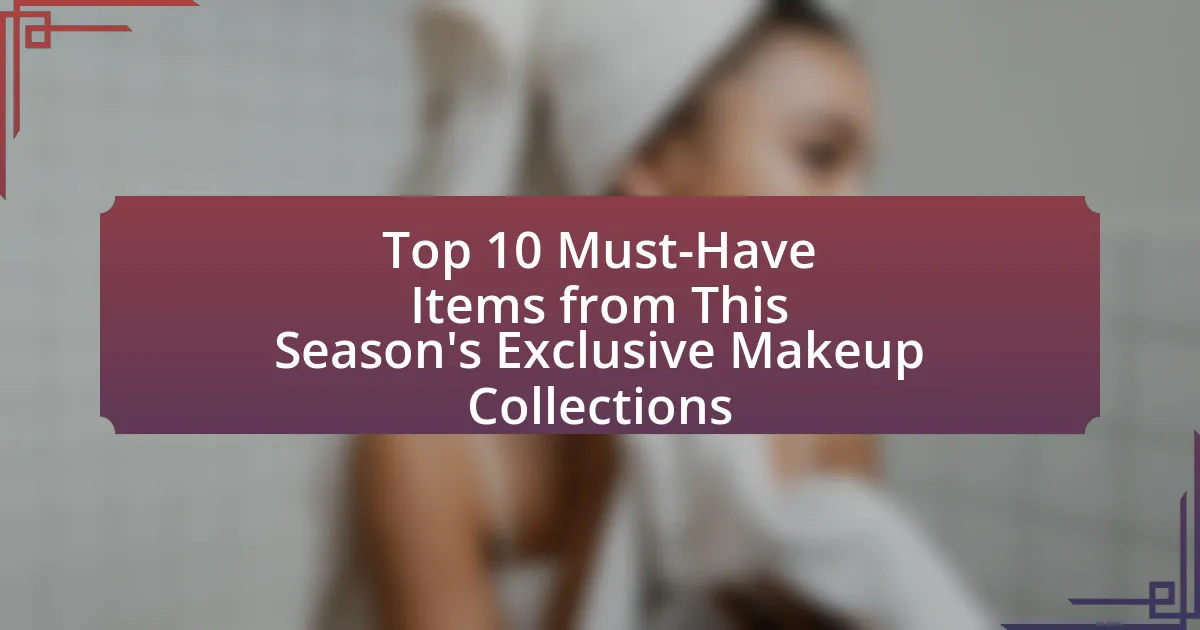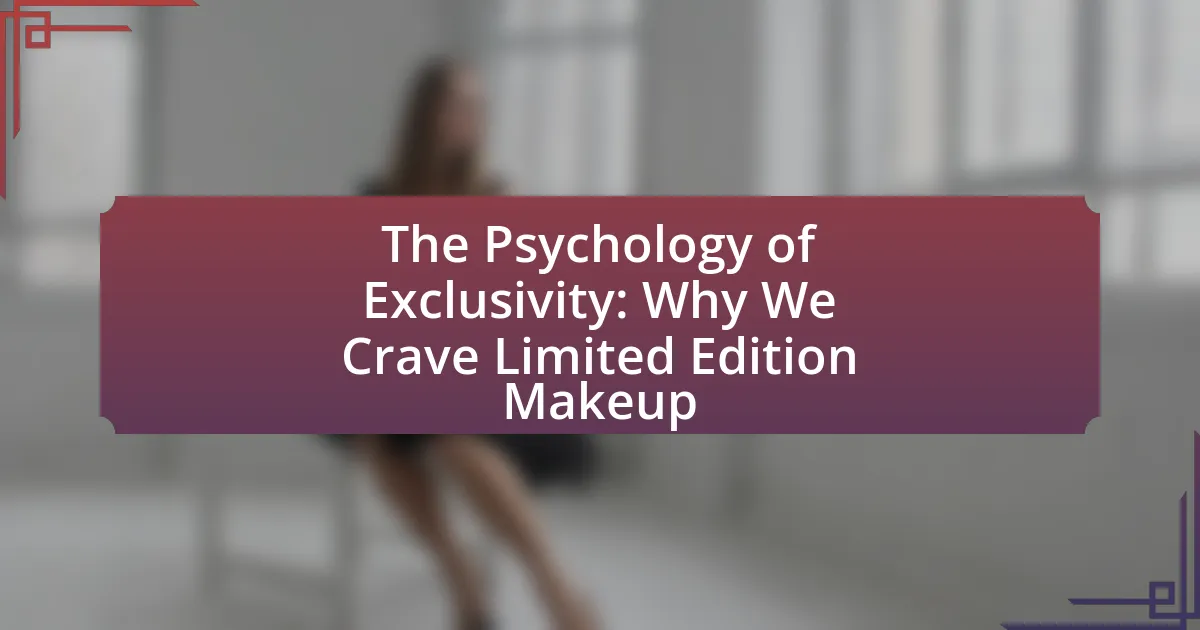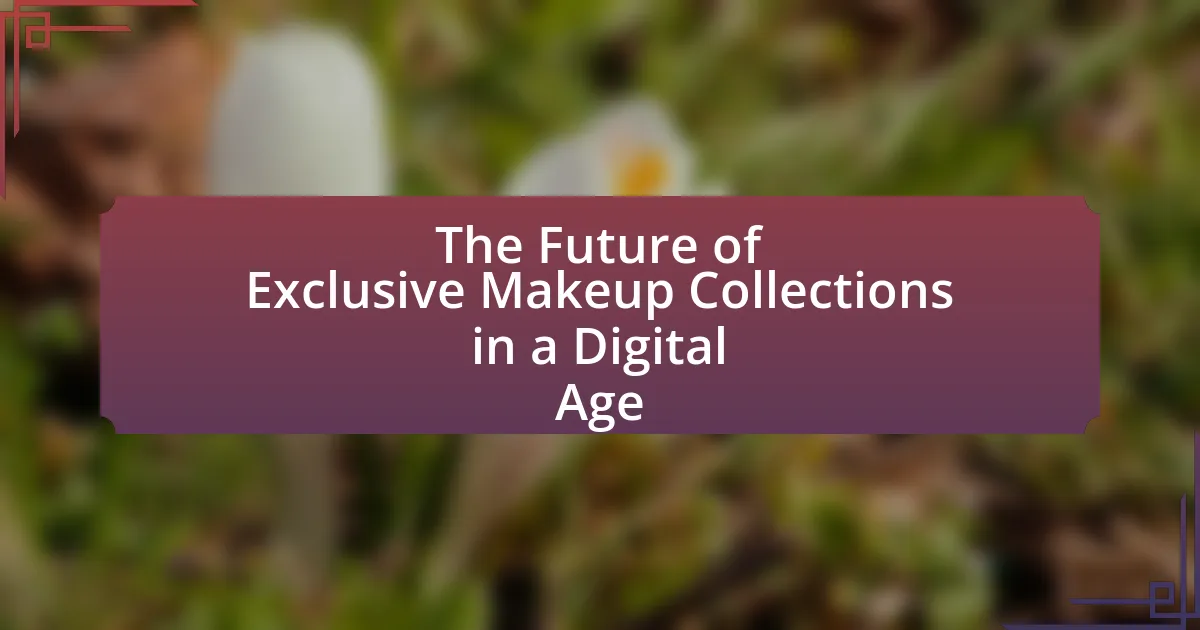The article examines the evolution of luxury makeup, highlighting its transition from ancient beauty rituals to contemporary high-end brands. It details how luxury makeup has changed over the decades, emphasizing inclusivity and innovation, particularly in the 21st century with the rise of social media. Key trends from the 20th century, such as the influence of iconic brands and celebrity endorsements, are discussed, alongside the impact of societal factors like sustainability and changing beauty standards. The article also explores the role of exclusivity in luxury makeup collections, the significance of limited editions, and the future trends shaping the industry, including technological advancements and consumer demand for eco-friendly practices.
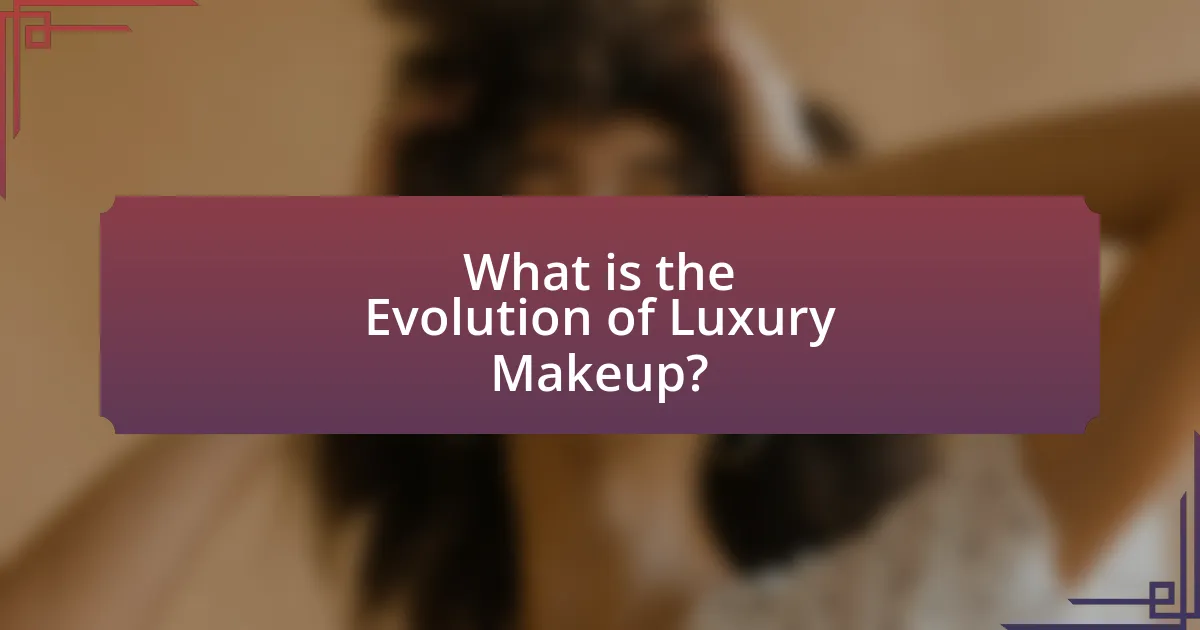
What is the Evolution of Luxury Makeup?
The evolution of luxury makeup has transitioned from ancient beauty rituals to modern high-end cosmetic brands. Initially, luxury makeup was characterized by the use of natural ingredients, such as crushed minerals and plant extracts, in ancient civilizations like Egypt and Greece, where beauty was closely tied to social status. In the 20th century, the introduction of synthetic materials and mass production allowed brands like Chanel and Dior to create iconic products, such as the Chanel No. 5 fragrance and Dior’s lipstick, which set new standards for luxury. The rise of social media and influencer culture in the 21st century has further transformed luxury makeup, with brands like Fenty Beauty and Pat McGrath Labs emphasizing inclusivity and innovative formulations, reflecting contemporary consumer values. This historical progression illustrates how luxury makeup has continually adapted to societal changes while maintaining its status as a symbol of prestige and self-expression.
How has luxury makeup changed over the decades?
Luxury makeup has evolved significantly over the decades, transitioning from exclusive, limited offerings to a more diverse and inclusive range of products. In the 1950s and 1960s, luxury makeup was characterized by classic brands like Chanel and Dior, which focused on timeless elegance and high-quality formulations. By the 1980s and 1990s, the introduction of bold colors and innovative textures marked a shift, with brands like Yves Saint Laurent leading the way in creating more expressive makeup options.
In the 2000s, luxury makeup began to embrace inclusivity, with brands expanding their shade ranges to cater to a broader audience, exemplified by Fenty Beauty’s launch in 2017, which offered 40 shades of foundation. This shift reflects a growing consumer demand for representation and diversity in beauty. Additionally, the rise of social media has transformed marketing strategies, allowing luxury brands to engage directly with consumers and showcase their products in real-time.
Overall, luxury makeup has transitioned from a focus on exclusivity and tradition to embracing innovation, inclusivity, and direct consumer engagement, reflecting broader societal changes and consumer preferences.
What were the defining trends in luxury makeup during the 20th century?
The defining trends in luxury makeup during the 20th century included the rise of iconic brands, the introduction of innovative products, and the influence of celebrity endorsements. In the early 1900s, brands like Chanel and Dior emerged, setting standards for elegance and sophistication in makeup. The 1920s saw the popularization of bold colors and the flapper aesthetic, while the post-World War II era introduced more diverse product lines, including foundations and lipsticks tailored for various skin tones. The 1960s and 1970s brought about a focus on eye makeup, with products like mascara and eyeliner becoming staples, influenced by fashion icons such as Twiggy. By the end of the century, luxury makeup brands began to emphasize skincare benefits in their products, reflecting a growing consumer demand for multifunctional cosmetics. These trends collectively shaped the luxury makeup landscape, establishing a foundation for contemporary beauty standards.
How did cultural shifts influence luxury makeup in the 21st century?
Cultural shifts significantly influenced luxury makeup in the 21st century by promoting inclusivity, sustainability, and self-expression. The rise of social media platforms, such as Instagram and TikTok, has democratized beauty standards, leading luxury brands to diversify their product lines to cater to a broader range of skin tones and preferences. For instance, Fenty Beauty launched in 2017 with 40 foundation shades, setting a new industry standard for inclusivity. Additionally, the growing awareness of environmental issues has prompted luxury makeup brands to adopt sustainable practices, such as using eco-friendly packaging and cruelty-free ingredients. This shift reflects a consumer demand for ethical products, as evidenced by a 2021 survey indicating that 70% of consumers prefer brands that demonstrate social responsibility. Thus, cultural shifts have reshaped luxury makeup by emphasizing diversity and sustainability, aligning with contemporary consumer values.
Why is the concept of exclusivity important in luxury makeup?
The concept of exclusivity is crucial in luxury makeup because it enhances brand prestige and consumer desirability. Exclusivity creates a perception of rarity, which drives demand among consumers who seek unique and high-status products. For instance, brands like Chanel and Tom Ford often release limited-edition collections that are only available for a short time, reinforcing their luxury status and appealing to consumers’ desire for unique offerings. This strategy not only elevates the brand’s image but also fosters a sense of belonging among consumers who own these exclusive products, thereby solidifying their loyalty and enhancing the overall market value of the brand.
What role do limited editions play in luxury makeup collections?
Limited editions in luxury makeup collections serve to create exclusivity and enhance brand prestige. By offering products in limited quantities, brands generate a sense of urgency among consumers, driving demand and encouraging immediate purchases. This strategy not only elevates the perceived value of the products but also fosters a unique connection between the brand and its customers, as owning a limited edition item signifies status and sophistication. Historical examples include Chanel’s limited edition collections, which often sell out quickly, demonstrating the effectiveness of this approach in maintaining brand allure and consumer interest.
How do brands create a sense of exclusivity for their products?
Brands create a sense of exclusivity for their products by implementing limited availability, unique branding, and high price points. Limited availability is achieved through restricted production runs or exclusive releases, which can create urgency and desirability among consumers. Unique branding often involves distinctive packaging, collaborations with renowned artists or designers, and storytelling that emphasizes heritage and craftsmanship. High price points reinforce the perception of luxury and exclusivity, as seen in brands like Chanel and Dior, where products are priced significantly higher than mass-market alternatives, thereby appealing to a wealthier clientele. These strategies collectively enhance the allure of the products, making them more desirable to consumers seeking status and uniqueness.
What are some iconic luxury makeup collections throughout history?
Some iconic luxury makeup collections throughout history include the Chanel Les Beiges collection, launched in 2013, which emphasizes natural beauty and skin health, and the Tom Ford Beauty collection, introduced in 2011, known for its high-quality formulations and sophisticated packaging. Additionally, the Dior Backstage collection, released in 2018, offers professional-grade products inspired by runway looks, while the YSL Touche Éclat, first launched in 1992, revolutionized highlighting and concealing with its innovative pen design. Each of these collections has significantly influenced makeup trends and consumer preferences, establishing themselves as benchmarks in the luxury cosmetics market.
Which brands have launched the most influential luxury makeup collections?
Chanel, Dior, and Tom Ford have launched the most influential luxury makeup collections. Chanel’s makeup line, particularly the Les Beiges collection, has set trends in natural beauty and skin luminosity since its introduction. Dior’s Backstage collection has revolutionized the accessibility of high-fashion makeup, offering professional-quality products to consumers. Tom Ford’s makeup line is renowned for its opulent packaging and high-performance formulas, establishing a standard for luxury in the beauty industry. These brands have consistently shaped consumer expectations and industry standards through innovative product offerings and marketing strategies.
What impact did these collections have on the beauty industry?
Exclusive collections have significantly transformed the beauty industry by setting new standards for luxury, innovation, and consumer engagement. These collections often introduce unique formulations, packaging, and branding strategies that elevate the overall consumer experience. For instance, brands like Chanel and Dior have launched limited-edition collections that not only drive sales but also create a sense of exclusivity and desirability among consumers. According to a report by Statista, the luxury cosmetics market is projected to reach $62 billion by 2024, indicating the substantial impact of these exclusive offerings on market growth. Furthermore, the rise of social media has amplified the visibility of these collections, allowing brands to engage directly with consumers and foster a community around luxury beauty products.
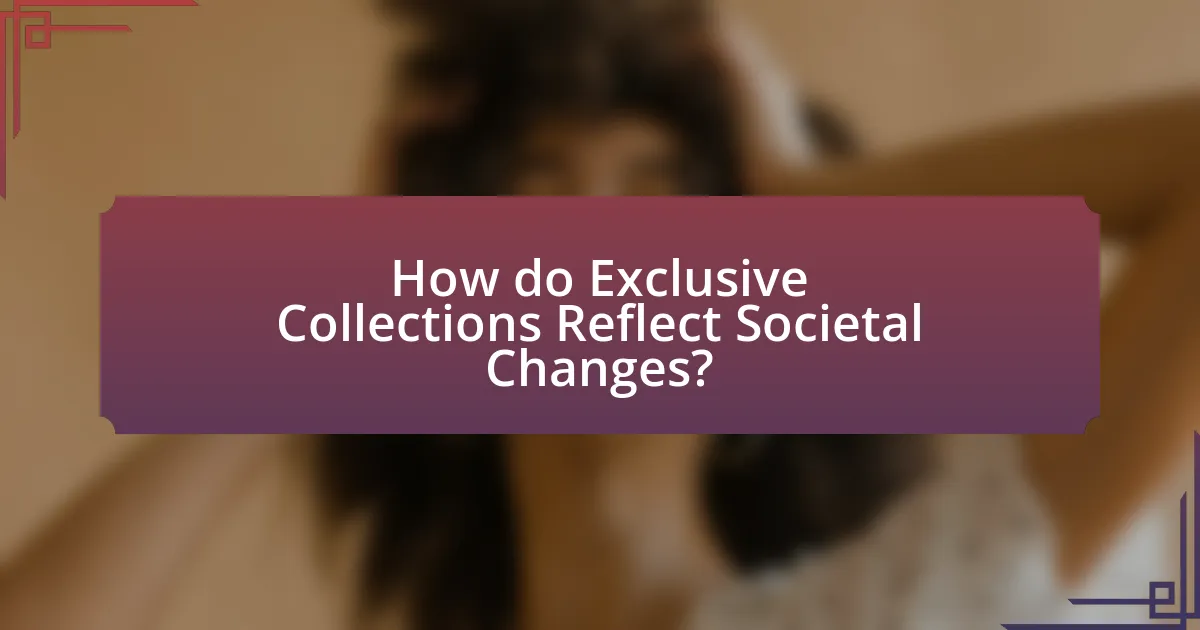
How do Exclusive Collections Reflect Societal Changes?
Exclusive collections in luxury makeup reflect societal changes by showcasing evolving beauty standards, cultural diversity, and consumer values. For instance, the rise of inclusivity in beauty products, such as Fenty Beauty’s extensive shade range, highlights a societal shift towards recognizing and celebrating diverse skin tones. This change is supported by data indicating that 67% of consumers prefer brands that reflect their values, emphasizing the importance of representation in marketing strategies. Additionally, limited-edition collections often respond to social movements, such as sustainability, with brands like Gucci Beauty launching eco-friendly packaging to align with growing environmental consciousness among consumers. These examples illustrate how exclusive collections serve as a mirror to the changing priorities and identities within society.
What societal factors have influenced luxury makeup collections?
Societal factors such as changing beauty standards, the rise of social media, and increased consumer awareness have significantly influenced luxury makeup collections. Changing beauty standards, driven by cultural shifts and diversity movements, have prompted brands to create inclusive product lines that cater to a wider range of skin tones and preferences. The rise of social media platforms, particularly Instagram and TikTok, has transformed how luxury makeup is marketed, with influencers and beauty gurus shaping consumer trends and driving demand for exclusive collections. Additionally, increased consumer awareness regarding sustainability and ethical practices has led luxury brands to incorporate eco-friendly ingredients and packaging, reflecting societal values and preferences. These factors collectively shape the offerings and marketing strategies of luxury makeup collections, aligning them with contemporary societal expectations.
How do beauty standards shape the development of luxury makeup products?
Beauty standards significantly influence the development of luxury makeup products by dictating the desired aesthetics and features that consumers aspire to achieve. These standards often reflect cultural ideals of beauty, which luxury brands leverage to create products that align with consumer expectations. For instance, the rise of the “glow” trend has led luxury brands to develop highlighters and illuminating foundations that cater to the demand for radiant skin, demonstrating how beauty ideals directly shape product offerings. Additionally, research indicates that brands that align their products with prevailing beauty standards tend to see increased sales and consumer loyalty, as seen in the success of brands like Fenty Beauty, which embraced inclusivity in its shade range to meet diverse beauty standards.
What role does celebrity culture play in luxury makeup marketing?
Celebrity culture significantly influences luxury makeup marketing by leveraging the star power of celebrities to enhance brand visibility and desirability. Brands often collaborate with high-profile figures to create exclusive product lines, which not only attract attention but also convey a sense of prestige and aspiration. For instance, collaborations like Rihanna’s Fenty Beauty and Kylie Jenner’s Kylie Cosmetics have demonstrated how celebrity endorsements can lead to substantial sales increases, with Fenty Beauty generating over $100 million in sales within its first 40 days. This strategy capitalizes on the emotional connection fans have with celebrities, making luxury products more appealing and driving consumer purchasing behavior.
How do luxury makeup brands respond to consumer demands?
Luxury makeup brands respond to consumer demands by innovating product offerings, enhancing customer experiences, and leveraging social media for engagement. For instance, brands like Chanel and Dior frequently launch limited-edition collections that reflect current beauty trends and consumer preferences, demonstrating their adaptability. Additionally, luxury brands invest in personalized services, such as bespoke makeup consultations, to cater to individual customer needs. According to a report by McKinsey & Company, 70% of consumers are influenced by social media when making beauty purchases, prompting luxury brands to actively engage with consumers through platforms like Instagram and TikTok, showcasing new products and trends. This strategic alignment with consumer behavior ensures that luxury makeup brands remain relevant and desirable in a competitive market.
What trends are currently shaping the luxury makeup market?
The luxury makeup market is currently shaped by trends such as sustainability, inclusivity, and digital innovation. Sustainability is driving brands to adopt eco-friendly packaging and ethically sourced ingredients, as consumers increasingly prioritize environmental responsibility. Inclusivity is evident in the expansion of shade ranges and products catering to diverse skin tones, reflecting a broader societal push for representation. Digital innovation, including augmented reality try-ons and personalized shopping experiences, enhances consumer engagement and convenience, aligning with the growing trend of online shopping. These trends are supported by market research indicating that 70% of consumers are willing to pay more for sustainable products, and brands that embrace inclusivity see a significant increase in customer loyalty and sales.
How do brands innovate to stay relevant in the luxury makeup space?
Brands innovate to stay relevant in the luxury makeup space by integrating cutting-edge technology, sustainable practices, and personalized experiences. For instance, many luxury brands now utilize augmented reality (AR) for virtual try-ons, enhancing customer engagement and convenience. Additionally, the shift towards eco-friendly packaging and clean beauty formulations reflects consumer demand for sustainability, with brands like Gucci Beauty and Dior leading the way in this trend. Furthermore, personalized products, such as custom shades and tailored skincare solutions, cater to individual preferences, exemplified by brands like Estée Lauder’s personalized foundation service. These strategies not only meet evolving consumer expectations but also reinforce brand loyalty and market position.
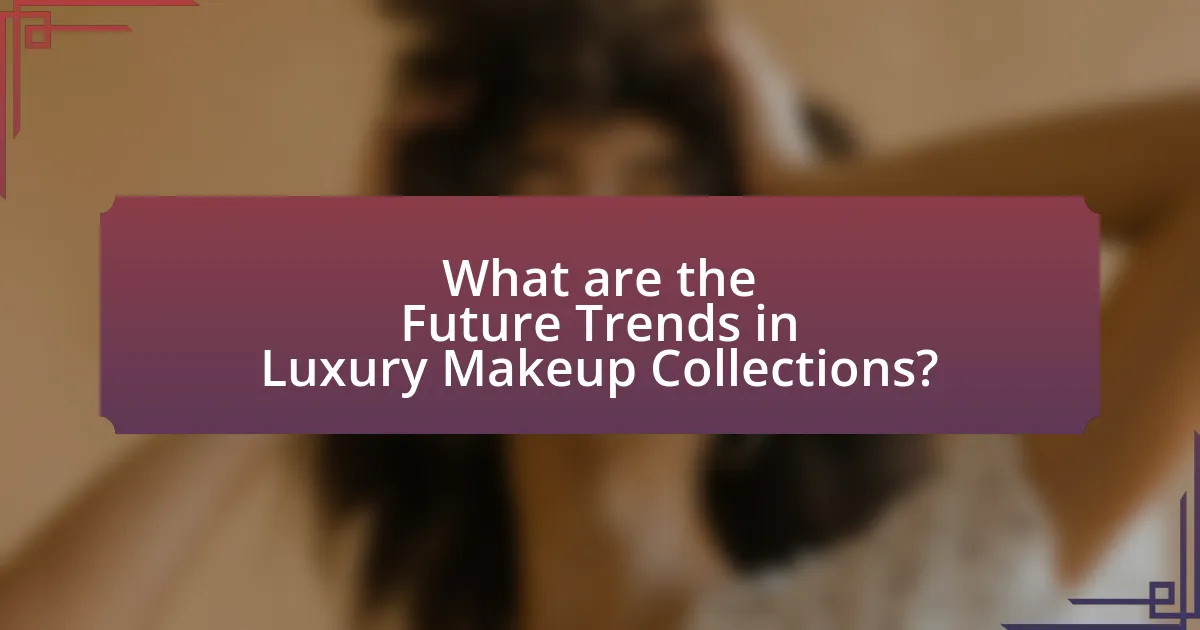
What are the Future Trends in Luxury Makeup Collections?
Future trends in luxury makeup collections include a focus on sustainability, personalization, and technological integration. Brands are increasingly prioritizing eco-friendly packaging and ethically sourced ingredients, responding to consumer demand for environmentally responsible products. Personalization is becoming prominent, with brands offering customizable products that cater to individual preferences and skin types. Additionally, the integration of technology, such as augmented reality for virtual try-ons and AI-driven recommendations, is enhancing the shopping experience. These trends are supported by market research indicating that 70% of consumers are willing to pay more for sustainable products, and the global market for personalized beauty is projected to reach $25 billion by 2025.
How is sustainability impacting luxury makeup collections?
Sustainability is significantly impacting luxury makeup collections by driving brands to adopt eco-friendly practices and materials. Many luxury makeup brands are now prioritizing sustainable sourcing of ingredients, utilizing biodegradable packaging, and reducing carbon footprints in their production processes. For instance, brands like Gucci Beauty and Dior have introduced refillable packaging options, which not only minimize waste but also appeal to environmentally conscious consumers. Additionally, a report by McKinsey & Company indicates that 67% of consumers consider sustainability when making luxury purchases, highlighting the growing demand for responsible luxury products. This shift towards sustainability is reshaping the luxury makeup landscape, as brands strive to align with consumer values and environmental standards.
What initiatives are luxury brands taking towards eco-friendly practices?
Luxury brands are increasingly adopting eco-friendly practices by implementing sustainable sourcing, reducing waste, and utilizing biodegradable materials. For instance, brands like Gucci and Stella McCartney have committed to using organic and recycled materials in their products, while Chanel has launched initiatives to minimize plastic use in packaging. Additionally, luxury brands are investing in carbon offset programs and promoting transparency in their supply chains to ensure ethical practices. These initiatives reflect a growing awareness of environmental impact, with many brands setting specific sustainability goals, such as achieving carbon neutrality by 2030.
How does consumer awareness of sustainability affect purchasing decisions?
Consumer awareness of sustainability significantly influences purchasing decisions by driving demand for eco-friendly products. Research indicates that 66% of global consumers are willing to pay more for sustainable brands, reflecting a shift towards prioritizing environmental impact in buying choices. This trend is particularly pronounced among younger demographics, with 73% of millennials stating they would change their consumption habits to reduce environmental impact. Brands that emphasize sustainable practices, such as using recyclable materials or ethical sourcing, often see increased customer loyalty and sales, demonstrating that consumer awareness directly correlates with purchasing behavior in the luxury makeup sector.
What technological advancements are influencing luxury makeup?
Technological advancements such as augmented reality (AR), artificial intelligence (AI), and innovative formulation techniques are significantly influencing luxury makeup. AR allows consumers to virtually try on products, enhancing the shopping experience and reducing return rates; for instance, brands like L’Oréal and Sephora have integrated AR into their apps. AI is utilized for personalized product recommendations and shade matching, improving customer satisfaction; companies like Estée Lauder employ AI to analyze skin tones and suggest suitable products. Additionally, advancements in formulation technology enable the creation of long-lasting, high-performance products that cater to diverse skin types, exemplified by brands like Fenty Beauty, which focuses on inclusivity and innovation in its product lines.
How are digital tools changing the way luxury makeup is marketed?
Digital tools are transforming luxury makeup marketing by enabling brands to engage consumers through personalized experiences and targeted advertising. For instance, augmented reality (AR) applications allow customers to virtually try on products, enhancing the shopping experience and increasing conversion rates. According to a report by McKinsey, brands that utilize AR in their marketing strategies see a 40% increase in customer engagement. Additionally, social media platforms facilitate direct interaction between brands and consumers, allowing for real-time feedback and community building. This shift towards digital engagement not only broadens reach but also fosters brand loyalty among consumers who value personalized and interactive experiences.
What innovations in product formulation are emerging in luxury makeup?
Innovations in product formulation emerging in luxury makeup include the incorporation of clean beauty ingredients, advanced skincare technology, and sustainable packaging solutions. Luxury brands are increasingly focusing on formulations that blend makeup with skincare benefits, utilizing ingredients like hyaluronic acid, peptides, and botanical extracts to enhance skin health while providing coverage. For instance, brands like Dior and Estée Lauder have introduced foundations that not only offer coverage but also improve skin texture and hydration over time. Additionally, the shift towards eco-friendly practices has led to the development of refillable packaging and biodegradable materials, aligning with consumer demand for sustainability. This trend is evidenced by brands such as Gucci Beauty, which emphasizes environmentally conscious formulations and packaging.
What are the best practices for selecting luxury makeup products?
The best practices for selecting luxury makeup products include researching brand reputation, evaluating ingredient quality, and testing product performance. Established luxury brands often have a history of quality and innovation, which can be verified through customer reviews and expert recommendations. High-quality ingredients, such as natural oils and pigments, contribute to better skin compatibility and overall performance, making them essential in luxury products. Additionally, testing products in-store or through samples allows consumers to assess texture, pigmentation, and wearability, ensuring that the selected items meet personal preferences and needs.
